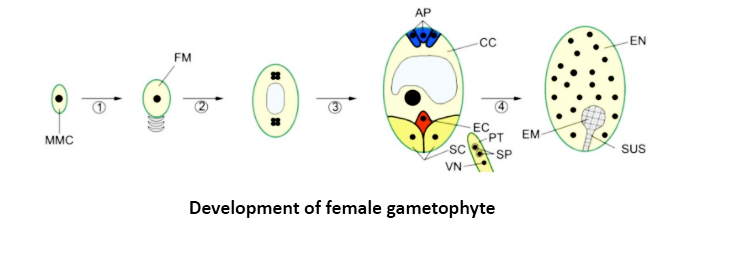Answer
395.1k+ views
Hint: The mature female gametophyte produces proteins to direct the pollen tube into the embryo sac, and contains protein complexes that prevent pre-fertilization seed growth.
Complete answer:

> A single cell from the internal tissue (called the nucellus) is known as a 'archesporal' cell in the developing ovule, which is expanded and transformed into the female meiocyte or megaspore mother cell (MMC). The MMC undergoes meiosis to generate four spores, three of which endure programmed cell death, retaining as functional megaspore only the proximal (chalazal) megaspore (FM stage or female gametophyte stage 1 or FG1 in each ovule).
> Then, the megaspore undergoes three sequential nuclear mitotic divisions, known as FG2 to FG4 stages, to produce the eight nuclei that will contribute to the differentiated embryo sac, four at each pole. Successive cellularization leads to seven cells being formed due to the nuclear migration of two of certain nuclei, called the polar nuclei (PN), that will represent the central nucleus of the cells.
> The micropylar (distal) end of the ovule is adjacent to the egg cell and to the two synergistic cells in the seven-celled embryo sac, while the chalazal (proximal) end of the ovule is adjacent to the three antipodal cells (AP). The central cell (CC) of homo-diploid (2n) occupies most of the embryo sac, and includes a large central vacuole. All the cells within the embryo sac are strongly polarised and have distinct morphologies.
> The precise migration and positioning of the nuclei at the eight-nucleate FG5 stage marks the distinction in their cell-fate specification between those nuclei. The two most distal nuclei form the potential synergids (SC) at the micropylar pole.
The more distal nucleus of the pair from the remaining two nuclei will form the future egg cell, while the more central nucleus will become one of the central cell's two polar nuclei. The centremost nucleus of the four nuclei from the chalazal pole will constitute the central cell's other polar nucleus. The above nucleus migrates to the micropylar pole and is situated near the first polar nucleus as the embryo sac is cellularized to form the seven-cell embryo sac.
After cellularization, the polar nuclei fuse to form the central homo-diploid nucleus of cells, and at the time of fertilisation the antipodal cells will degenerate.
Note: Spores undergo cell proliferation and differentiation to develop into gametophytes. The major function of gametophyte generation is to produce haploid gametes.
Complete answer:

> A single cell from the internal tissue (called the nucellus) is known as a 'archesporal' cell in the developing ovule, which is expanded and transformed into the female meiocyte or megaspore mother cell (MMC). The MMC undergoes meiosis to generate four spores, three of which endure programmed cell death, retaining as functional megaspore only the proximal (chalazal) megaspore (FM stage or female gametophyte stage 1 or FG1 in each ovule).
> Then, the megaspore undergoes three sequential nuclear mitotic divisions, known as FG2 to FG4 stages, to produce the eight nuclei that will contribute to the differentiated embryo sac, four at each pole. Successive cellularization leads to seven cells being formed due to the nuclear migration of two of certain nuclei, called the polar nuclei (PN), that will represent the central nucleus of the cells.
> The micropylar (distal) end of the ovule is adjacent to the egg cell and to the two synergistic cells in the seven-celled embryo sac, while the chalazal (proximal) end of the ovule is adjacent to the three antipodal cells (AP). The central cell (CC) of homo-diploid (2n) occupies most of the embryo sac, and includes a large central vacuole. All the cells within the embryo sac are strongly polarised and have distinct morphologies.
> The precise migration and positioning of the nuclei at the eight-nucleate FG5 stage marks the distinction in their cell-fate specification between those nuclei. The two most distal nuclei form the potential synergids (SC) at the micropylar pole.
The more distal nucleus of the pair from the remaining two nuclei will form the future egg cell, while the more central nucleus will become one of the central cell's two polar nuclei. The centremost nucleus of the four nuclei from the chalazal pole will constitute the central cell's other polar nucleus. The above nucleus migrates to the micropylar pole and is situated near the first polar nucleus as the embryo sac is cellularized to form the seven-cell embryo sac.
After cellularization, the polar nuclei fuse to form the central homo-diploid nucleus of cells, and at the time of fertilisation the antipodal cells will degenerate.
Note: Spores undergo cell proliferation and differentiation to develop into gametophytes. The major function of gametophyte generation is to produce haploid gametes.
Recently Updated Pages
Basicity of sulphurous acid and sulphuric acid are

What is the stopping potential when the metal with class 12 physics JEE_Main

The momentum of a photon is 2 times 10 16gm cmsec Its class 12 physics JEE_Main

Using the following information to help you answer class 12 chemistry CBSE

Which of the following would not be a valid reason class 11 biology CBSE

Why should electric field lines never cross each other class 12 physics CBSE

Trending doubts
Difference between Prokaryotic cell and Eukaryotic class 11 biology CBSE

Fill the blanks with the suitable prepositions 1 The class 9 english CBSE

Two charges are placed at a certain distance apart class 12 physics CBSE

Difference Between Plant Cell and Animal Cell

What organs are located on the left side of your body class 11 biology CBSE

Change the following sentences into negative and interrogative class 10 english CBSE

The planet nearest to earth is A Mercury B Venus C class 6 social science CBSE

The Equation xxx + 2 is Satisfied when x is Equal to Class 10 Maths

What is BLO What is the full form of BLO class 8 social science CBSE



